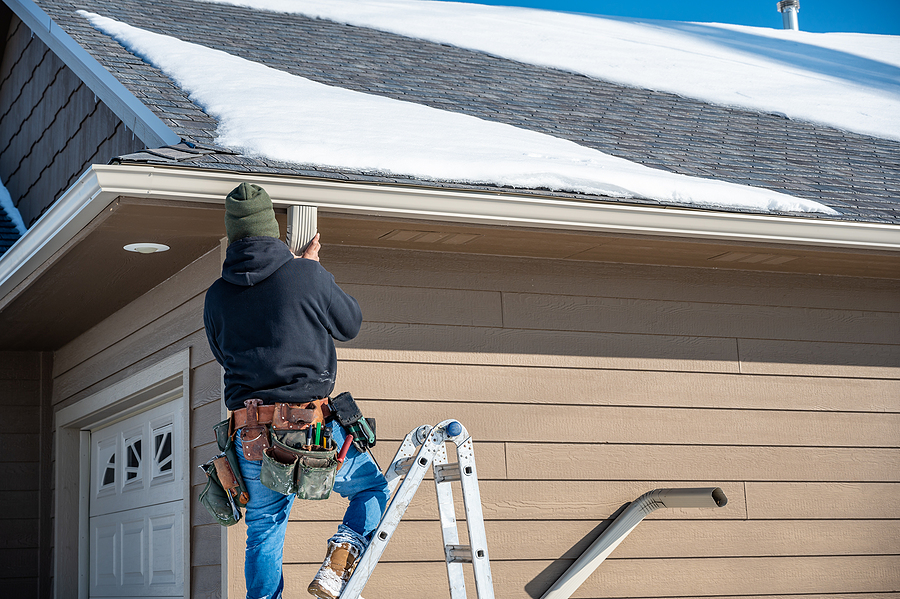
How to Identify and Address Common Gutter Problems
Gutters play a crucial role in protecting your home from water damage by directing rainwater away from your foundation and landscaping. However, they can encounter several problems over time. Understanding how to identify and address these common gutter issues is essential for any homeowner. This blog post will explore some of the typical gutter problems and offer practical solutions, helping you determine when it’s time to call in professional help.
Clogging
Clogged gutters are a frequent issue faced by many homeowners. Understanding the causes, maintenance options, and risks associated with clogged gutters is vital for effective home maintenance.
Identifying the Problem:
Clogging is one of the most common gutter issues. It usually occurs when leaves, twigs, and other debris accumulate in the gutter, obstructing the flow of water. Signs of clogged gutters include water spilling over the sides, no water flow from downspouts, and visible debris in the gutters.
Remedying the Issue:
Regular cleaning is the best way to prevent gutter clogging. This involves physically removing debris from the gutters and downspouts. Installing gutter guards can also be an effective long-term solution to minimize the accumulation of debris.
Potential Causes of Clogging
- Natural Debris: The primary cause of gutter clogging is the accumulation of natural debris such as leaves, twigs, and pine needles. This is especially common in homes surrounded by trees.
- Bird Nests and Pests: Gutters can also become clogged due to the nesting of birds and small animals or the accumulation of mud and dirt, often exacerbated by pests.
- Roof Materials: Sometimes, materials from the roof, like granules from asphalt shingles, can wash into the gutters and contribute to clogging.
Tools and Maintenance Options
- Regular Cleaning: The most straightforward way to prevent gutter clogging is by regular cleaning. This can be done using a ladder, gloves, a garden trowel, or a gutter scoop.
- Gutter Guards: Installing gutter guards can significantly reduce the amount of debris entering the gutters. These guards come in various styles, including mesh screens, foam guards, and brush filters.
- Professional Cleaning Services: For those uncomfortable with heights or lacking time, hiring a professional gutter cleaning service is a practical option. These services have the right tools and expertise to efficiently clean and maintain gutters.
Risks of Ignoring Clogged Gutters
- Water Damage: Clogged gutters can cause water to overflow and accumulate around the foundation of the house, leading to basement flooding or damage to the home’s foundation.
- Roof Damage: The excess water can also back up into the roof system, causing rot or mold in the roof and attic spaces.
- Pest Infestations: Clogged gutters can create a hospitable environment for pests like mosquitoes, ants, and rodents.
- Damage to Gutter System: The weight of trapped water and debris can cause gutters to sag, detach from the house, or become permanently damaged, necessitating costly repairs or replacement.
Regular maintenance and timely action to clear clogs are essential to prevent these risks and ensure the longevity and effectiveness of your gutter system.

Addressing the Issue of Gutter Clogging
To effectively deal with gutter clogging, a proactive approach is key. Homeowners should plan regular gutter cleanings, especially after the fall season when leaves are most likely to accumulate. For those living in heavily wooded areas, more frequent cleanings might be necessary.
The installation of gutter guards is an investment that can reduce the frequency of clogs and cleaning. However, it’s important to note that while guards significantly reduce the amount of debris that enters the gutters, they do not eliminate the need for occasional cleaning.
Leaking
Gutter leaks are a significant issue that can compromise the integrity of a home’s structure and foundation. Leaks typically occur due to various reasons, and understanding these causes, along with effective solutions, is key to maintaining the health of your gutter system.
Causes of Gutter Leaks
Gutter leaks often stem from cracks or holes in the gutter material. These can develop over time due to natural wear and tear, weather conditions, or corrosion in metal gutters. Another common cause of leaks is the loosening of joints between gutter sections. This can happen due to poor gutter installation, shifting of the house structure, or the expansion and contraction of materials with temperature changes. Sometimes, leaks may also be the result of clogged downspouts forcing water to escape through any small openings in the gutter system.
Addressing Gutter Leaks
The approach to fixing gutter leaks largely depends on the extent and location of the damage. For small cracks or holes, a waterproof sealant or gutter repair tape can be an effective solution. These materials are readily available at hardware stores and can be applied without the need for professional help.
If the leak is due to a loose joint, resecuring or replacing the gutter hangers and brackets can help. It’s crucial to ensure that all parts of the gutter are firmly attached and aligned correctly to prevent future leaks.
In cases where the gutter is extensively corroded or damaged, it may be more cost-effective in the long run to replace sections of the gutter, or even the entire system, especially if the gutters are old.
Risks of Untreated Gutter Leaks
Leaving gutter leaks unaddressed can lead to several issues. Water escaping from leaks can damage the exterior walls, siding, and even the foundation of a house. Over time, this can lead to costly repairs and structural problems. Additionally, leaking gutters can create ideal conditions for mold and mildew growth on the exterior walls, which not only damages the paint and siding but can also pose health risks.
Persistent leaks can also lead to soil erosion around the house, affecting landscaping and potentially leading to instability in the foundation. In winter, water from leaking gutters can freeze and create ice dams, leading to further damage to the roof and gutter system.

Remedying the Issue:
Small leaks can often be repaired using a waterproof sealant or gutter repair tape. However, larger leaks or multiple damaged areas might require professional attention, especially if the gutters are old or heavily worn.
Regular inspection of gutters for any signs of leaks and timely repairs are crucial in maintaining the effectiveness and longevity of your gutter system. Addressing leaks promptly not only protects your home from water-related damage but also ensures the smooth functioning of the entire gutter system. For more extensive issues, consulting with professional gutter repair services can provide a more permanent solution.
Sagging Gutters
Sagging gutters are a common problem that can lead to significant issues if not rectified. Understanding the causes, addressing the problem, and recognizing the risks associated with sagging gutters are important steps in maintaining the health of your home’s drainage system.
Understanding the Causes of Sagging Gutters
Sagging gutters typically occur due to a few key reasons. One of the most common is the weight of debris, such as leaves and twigs, accumulating over time. This excess weight can strain the gutter hangers, leading to sagging. Additionally, weather-related wear and tear can weaken the gutter material and its supporting hardware. In areas with heavy snowfall, the weight of the snow can also cause gutters to sag. Improper installation or inadequate support for the gutter’s length can further contribute to this problem.
Addressing the Problem
Fixing sagging gutters often involves a combination of cleaning, repairing, and reinforcing:
- Cleaning: The first step is to remove any debris from the gutters. This alleviates the weight and strain on the gutter system and allows for a better assessment of the damage.
- Assessing and Repairing Hardware: Inspect gutter hangers and mounting hardware. If hangers are spaced too far apart, adding more can provide additional support. Loose or damaged hangers should be tightened or replaced.
- Checking Gutter Alignment: Ensure that gutters are correctly aligned. They should have a slight slope towards the downspouts for proper drainage. Realigning may be necessary if they have been knocked out of position.
- Reinforcing the Gutter System: In some cases, reinforcing the gutter system with additional supports or stronger materials can prevent future sagging. This is especially important in areas prone to heavy snow or rainfall.
Risks of Ignoring Sagging Gutters
Leaving sagging gutters unrepaired can lead to several issues. The improper drainage caused by sagging can result in water overflow, which can damage the siding, foundation, and landscaping of your home. Additionally, sagging gutters are more prone to accumulating debris, which can lead to clogging and further exacerbate drainage issues.
In extreme cases, sagging gutters can completely pull away from the house, leading to costly repairs. The standing water in improperly drained gutters can also attract pests and lead to mold and mildew growth.
Sagging gutters, while a common issue, require prompt attention to prevent further damage to your home. Regular maintenance, timely repairs, and appropriate reinforcement of the gutter system can ensure that your gutters function effectively and protect your home from water-related damages. For extensive issues, seeking professional advice can provide long-term solutions and peace of mind.

Improper Drainage
Improper drainage in gutter systems is not just a minor inconvenience but a potential hazard to the integrity of your home. It’s essential to understand the causes and solutions to this issue, as well as the risks involved if left unaddressed.
Understanding the Causes
The root causes of improper gutter drainage can vary. Commonly, it’s due to incorrect installation or alignment of the gutter system. Gutters need a slight slope towards the downspouts to facilitate proper water flow; if this slope is insufficient or non-existent, water will not drain effectively. Another cause can be blockages in the gutters or downspouts, where debris prevents water from flowing freely. In some cases, the design of the gutter system itself might be inadequate for the size or style of the house, or the downspouts may be insufficient in number or size to handle the volume of water.
Addressing the Problem
To correct improper drainage, the following steps can be taken:
- Inspect and Clean Gutters: Regularly clean your gutters and downspouts to ensure they are free of debris. This simple step can often rectify many drainage issues.
- Adjust the Gutter Slope: Check the slope of your gutters. They should drop about a quarter inch for every 10 feet toward the downspout. Adjustments might be necessary to achieve this slope.
- Examine and Clear Downspouts: Ensure that downspouts are not clogged and are efficiently channeling water away from the house. Water should be directed at least three feet away from the foundation.
- Evaluate Gutter Size and Design: Assess whether your gutters are appropriately sized for your house. In areas with heavy rainfall, larger gutters and additional downspouts may be necessary.
- Consider Professional Assessment: If you’re unsure about the adequacy of your gutter system, a professional can assess whether it meets the needs of your home and propose necessary modifications.
Risks of Neglecting Improper Drainage
Ignoring issues of improper gutter drainage can lead to several significant problems:
- Water Damage: Poor drainage can cause water to overflow and seep into the home’s foundation, leading to basement flooding and structural damage.
- Soil Erosion: Overflowing gutters can lead to soil erosion around the house, affecting landscaping and potentially the stability of the foundation.
- Siding Damage: Water spilling over gutters can also damage the siding and exterior of the house, leading to costly repairs.
- Mold and Mildew Growth: Excess moisture due to improper drainage can create ideal conditions for mold and mildew growth, which pose health risks and can damage your home’s interior and exterior.
Addressing issues with improper gutter drainage is vital in safeguarding the structural integrity and longevity of your home. Regular maintenance, correct alignment, and ensuring that your gutter system is adequately designed for your home are key steps in preventing drainage problems. In many cases, seeking the expertise of professionals can provide the most effective and lasting solutions.

Overflowing
Overflowing gutters are more than just a nuisance; they can be indicative of deeper issues within your gutter system and potentially lead to significant damage to your property. Understanding why gutters overflow, how to effectively address this issue, and the risks involved is crucial for maintaining the health and safety of your home.
Understanding the Causes
Overflowing gutters can have several causes, each requiring a specific approach to remedy:
- Clogs and Blockages: The most common cause of overflowing gutters is blockages from leaves, twigs, and other debris. When gutters are clogged, water can’t flow to the downspouts and instead spills over the sides.
- Insufficient Gutter Size or Poor Design: Sometimes, the gutters may be too small to handle the volume of water they receive, especially during heavy rainfalls. This is often a design issue where the gutter system is not adequately tailored to the size and style of the house.
- Improperly Positioned Downspouts: If downspouts are not correctly placed or there aren’t enough of them, it can lead to water buildup and overflow.
- Damaged or Sagging Gutters: Damaged or sagging sections of gutter can impede water flow and cause overflows at certain points along the gutter system.
Addressing Overflowing Gutters
To effectively tackle overflowing gutters, consider the following solutions:
- Regular Cleaning: Regularly cleaning your gutters is crucial. Removing debris from the gutters and downspouts ensures that water can flow freely.
- Gutter Guards: Installing gutter guards can prevent debris from entering the gutter system, thereby reducing the likelihood of clogs.
- Assessing and Adjusting Gutter Size: If your gutters are consistently overflowing during heavy rains, it might be time to assess whether they are adequately sized for your home. Consulting with a gutter installation expert can help determine if a larger gutter size is needed.
- Adding or Repositioning Downspouts: Increasing the number of downspouts, or repositioning them, can enhance the capacity of your gutter system to drain water effectively.
- Repairing Damaged Gutters: Address any damage or sagging in your gutters promptly. In some cases, partial or complete replacement may be necessary.
Risks of Ignoring Overflowing Gutters
Neglecting gutter overflow issues can lead to several problems:
- Foundation Damage: Continuous overflows can lead to water pooling around the foundation of your home, which can cause cracking, weakening, and in severe cases, structural failure.
- Siding and Exterior Damage: Water spilling over the gutters can damage your home’s siding, paint, and exterior surfaces, leading to rot and decay.
- Landscaping Erosion: Overflowing water can erode the landscaping around your home, damaging plants and affecting the overall aesthetics of your property.
- Basement Flooding: Water overflow near the foundation can seep into basements, causing flooding and associated water damage.
Properly addressing and preventing gutter overflows is essential in protecting your home from water damage and maintaining its structural integrity. Regular maintenance, appropriate gutter sizing, and timely repairs are key to ensuring effective water management through your gutter system. For complex issues, seeking professional assistance can provide the most effective and long-lasting solutions.

Ice Dams
Ice dams in gutters are a significant issue in colder climates, particularly during the winter months. They not only impede the proper functioning of your gutter system but can also lead to substantial damage if not addressed promptly. Understanding the formation of ice dams, effective preventative measures, and the risks they pose is vital for homeowners in ensuring the longevity and safety of their homes.
Understanding Ice Dam Formation
Ice dams occur when snow on the roof melts and then refreezes at the edge of the roof, typically in the gutters. This process creates a barrier of ice that prevents melting snow from draining off the roof. The primary cause of ice dams is a warm attic, which causes snow on the roof to melt. As the water runs down the roof and reaches the eaves, which are colder, it refreezes and gradually forms an ice dam.
Preventing Ice Dams
Preventing ice dams involves a combination of adequate insulation, ventilation, and gutter maintenance:
- Improving Attic Insulation: Proper insulation in the attic keeps the heat in your home from rising to the roof, thereby preventing the melting and refreezing cycle that leads to ice dams.
- Ensuring Adequate Ventilation: Good attic ventilation keeps the underside of the roof cool, further reducing the chances of snow melting and refreezing at the eaves.
- Gutter Maintenance: Keeping gutters clean and clear of debris helps ensure that melting snow can drain properly before it has the chance to refreeze in the gutters.
Addressing Existing Ice Dams
If ice dams have already formed, it’s important to remove them safely to prevent damage:
- Calcium Chloride Ice Melter: Applying a calcium chloride ice melter can help melt the ice dam. It’s essential to use calcium chloride, not rock salt, which can damage the roof.
- Professional Ice Dam Removal: For severe ice dams, professional removal may be necessary. Professionals have the tools and techniques to safely remove ice dams without damaging your roof or gutters.

Risks of Ignoring Ice Dams
Leaving ice dams unaddressed can lead to significant issues:
- Roof Damage: Ice dams can cause water to back up under roof shingles, leading to leaks and damage to the roof structure.
- Gutter Damage: The weight of ice can cause gutters to sag, detach, or even collapse, necessitating costly repairs or replacement.
- Interior Water Damage: As ice dams prevent proper drainage, water can seep into the home, causing damage to walls, ceilings, insulation, and creating conditions conducive to mold growth.
- Safety Hazards: Falling icicles or chunks of ice from ice dams can pose safety hazards to people and pets.
Dealing with ice dams is crucial for maintaining the structural integrity of your roof and gutter system, especially in colder regions. Preventative measures like improving attic insulation and ventilation, along with regular gutter maintenance, are key to mitigating the formation of ice dams. For existing ice dams, safe removal techniques or professional assistance are essential to prevent damage to your home.
Regular inspection and maintenance are key to keeping your gutter system functioning properly. Addressing issues early can prevent more significant problems down the line. However, some problems might be beyond the scope of DIY and require professional expertise.in
If you’re experiencing persistent gutter issues or are unsure how to address them, Gutters Zone is here to help. Our professional gutter installation and repair services ensure that your gutters are in top condition, protecting your home from water damage. We are prepared with free and reliable quotes to connect you with expert gutter companies today.
